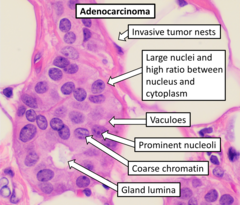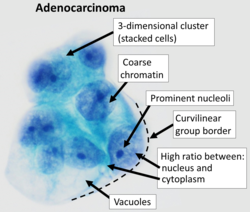Definition and Characteristics of Adenocarcinoma
- Adenocarcinoma is a cancerous tumor that originates from epithelial tissue with glandular origin or characteristics.
- Adenocarcinomas are part of the larger group of carcinomas.
- The visual features of adenocarcinoma vary substantially between subtypes and individual cases.
- Adenocarcinomas can arise in many tissues of the body due to the ubiquitous nature of glands.
Examples of Adenocarcinomas in Different Organs
- Esophageal cancer: Most cases in developed countries are adenocarcinomas.
- Pancreatic cancer: Over 80% of pancreatic cancers are ductal adenocarcinomas.
- Prostate cancer: Nearly all cases of prostate cancer are adenocarcinomas.
- Cervical cancer: Approximately 10-15% of cervical cancers are adenocarcinomas.
- Stomach cancer: Almost all stomach cancers are adenocarcinomas, except for rare cases of extranodal marginal zone B-cell lymphomas.
- Breast cancer: Most breast cancers are adenocarcinomas.
- Colon cancer: The vast majority of colorectal cancers are adenocarcinomas.
- Lung cancer: Adenocarcinoma is the most common form of lung cancer, accounting for nearly 40% of cases.
Adenocarcinomas in Breast Cancer
- The three most common histopathological types of breast cancer are invasive ductal carcinoma, ductal carcinoma in situ, and invasive lobular carcinoma.
- Invasive ductal carcinoma accounts for 55% of breast cancers.
- Ductal carcinoma in situ represents 13% of breast cancers.
- Invasive lobular carcinoma accounts for 5% of breast cancers.
Adenocarcinomas in Colon Cancer
- Normal colonic glands secrete mucus into the colon to lubricate the feces.
- Genetic changes in these glands can lead to the development of invasive adenocarcinoma.
- Colonoscopy is used to detect and remove adenomas and polyps to prevent the progression to adenocarcinoma.
- Malignant adenocarcinomas in the colon exhibit changes in appearance, structure, and increased mitosis.
Adenocarcinomas in Lung Cancer
- Smoking is a common risk factor for adenocarcinoma, but it can also occur in never-smokers.
- Bronchioloalveolar carcinoma, a subtype of adenocarcinoma, is more common in female never-smokers.
- Adenocarcinoma is typically seen peripherally in the lungs compared to other types of lung cancer.
- Adenocarcinoma of the lung is often associated with mutations in genes like EGFR and ALK.
- The prognosis and treatment options for adenocarcinoma depend on various factors, including the stage of the disease.
Adenocarcinoma (/ˌædɪnoʊkɑːrsɪˈnoʊmə/; plural adenocarcinomas or adenocarcinomata /ˌædɪnoʊkɑːrsɪˈnoʊmətə/; AC) is a type of cancerous tumor that can occur in several parts of the body. It is defined as neoplasia of epithelial tissue that has glandular origin, glandular characteristics, or both. Adenocarcinomas are part of the larger grouping of carcinomas, but are also sometimes called by more precise terms omitting the word, where these exist. Thus invasive ductal carcinoma, the most common form of breast cancer, is adenocarcinoma but does not use the term in its name—however, esophageal adenocarcinoma does to distinguish it from the other common type of esophageal cancer, esophageal squamous cell carcinoma. Several of the most common forms of cancer are adenocarcinomas, and the various sorts of adenocarcinoma vary greatly in all their aspects, so that few useful generalizations can be made about them.
| Adenocarcinoma | |
|---|---|
 | |
| Histopathology of typical features of adenocarcinoma on H&E stain, but in reality the visual features vary substantially, both by subtypes of adenocarcinoma as well as between individual cases. | |
| Specialty | Oncology, Pathology |

In the most specific usage, the glandular origin or traits are exocrine; endocrine gland tumors, such as a VIPoma, an insulinoma, or a pheochromocytoma, are typically not referred to as adenocarcinomas but rather are often called neuroendocrine tumors. Epithelial tissue sometimes includes, but is not limited to, the surface layer of skin, glands, and a variety of other tissue that lines the cavities and organs of the body. Epithelial tissue can be derived embryologically from any of the germ layers (ectoderm, endoderm, or mesoderm). To be classified as adenocarcinoma, the cells do not necessarily need to be part of a gland, as long as they have secretory properties. Adenocarcinoma is the malignant counterpart to adenoma, which is the benign form of such tumors. Sometimes adenomas transform into adenocarcinomas, but most do not.
Well-differentiated adenocarcinomas tend to resemble the glandular tissue that they are derived from, while poorly differentiated adenocarcinomas may not. By staining the cells from a biopsy, a pathologist can determine whether the tumor is an adenocarcinoma or some other type of cancer. Adenocarcinomas can arise in many tissues of the body owing to the ubiquitous nature of glands within the body, and, more fundamentally, to the potency of epithelial cells. While each gland may not be secreting the same substance, as long as there is an exocrine function to the cell, it is considered glandular and its malignant form is therefore named adenocarcinoma.
From adeno- + carcinoma.
adenocarcinoma (plural adenocarcinomas or adenocarcinomata)